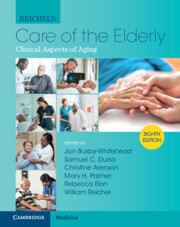Book contents
- Reichel’s Care of the Elderly
- Reichel’s Care of the Elderly
- Copyright page
- In Memoriam
- Contents
- Contributors
- Section I General Approach to the Care of the Elderly
- Section II Geriatric Syndromes
- Section III Care of the Elderly by Organ System
- Section IV Principles of Care for the Elderly
- Chapter 46 Surgical Principles
- Chapter 47 Rehabilitation
- Chapter 48 Geriatric Sexuality
- Chapter 49 Aging in Adults with Intellectual Disabilities and Severe and Persistent Mental Illness
- Chapter 50 Home- and Community-Based Long-Term Care
- Chapter 51 Institutional Post-Acute and Long-Term Care Medicine
- Chapter 52 Hospital-Based Care
- Chapter 53 Introduction to Palliative Care
- Chapter 54 The Mistreatment of Older Adults
- Chapter 55 Driving and the Older Adult
- Chapter 56 Integrative Medicine
- Chapter 57 Retirement
- Chapter 58 Cultural Competence
- Chapter 59 Health Literacy
- Chapter 60 Caregiving
- Chapter 61 Practice Transformation for Better Care of Older Adults
- Chapter 62 Health-Care Organization and Financing
- Chapter 63 Ethical Decision-Making
- Chapter 64 Epidemic and Pandemic Impacts on the Elderly Population
- Index
- Plate Section (PDF Only)
- References
Chapter 50 - Home- and Community-Based Long-Term Care
from Section IV - Principles of Care for the Elderly
Published online by Cambridge University Press: 30 June 2022
- Reichel’s Care of the Elderly
- Reichel’s Care of the Elderly
- Copyright page
- In Memoriam
- Contents
- Contributors
- Section I General Approach to the Care of the Elderly
- Section II Geriatric Syndromes
- Section III Care of the Elderly by Organ System
- Section IV Principles of Care for the Elderly
- Chapter 46 Surgical Principles
- Chapter 47 Rehabilitation
- Chapter 48 Geriatric Sexuality
- Chapter 49 Aging in Adults with Intellectual Disabilities and Severe and Persistent Mental Illness
- Chapter 50 Home- and Community-Based Long-Term Care
- Chapter 51 Institutional Post-Acute and Long-Term Care Medicine
- Chapter 52 Hospital-Based Care
- Chapter 53 Introduction to Palliative Care
- Chapter 54 The Mistreatment of Older Adults
- Chapter 55 Driving and the Older Adult
- Chapter 56 Integrative Medicine
- Chapter 57 Retirement
- Chapter 58 Cultural Competence
- Chapter 59 Health Literacy
- Chapter 60 Caregiving
- Chapter 61 Practice Transformation for Better Care of Older Adults
- Chapter 62 Health-Care Organization and Financing
- Chapter 63 Ethical Decision-Making
- Chapter 64 Epidemic and Pandemic Impacts on the Elderly Population
- Index
- Plate Section (PDF Only)
- References
Summary
As the population ages, the need for home and community-based care is expected to rise. This chapter discusses public and private funding sources to help older adults with dependencies in their activities of daily living stay in their homes or find alternate community residential options. It explains the basics of the Older Americans Act, Medicaid waivers, the limited Medicare support for care at home, care of special populations such as veterans, Native Americans, and Native Alaska Elders, older adults with dementia, and those with mental health challenges. Residential housing options, assisted living communities, continuing care communities, and newer models for residential support including villages and naturally occurring retirement communities are discussed. Workforce challenges in providing care to the aging population are presented as a key factor in creating successful service programs.
Keywords
- Type
- Chapter
- Information
- Reichel's Care of the ElderlyClinical Aspects of Aging, pp. 620 - 630Publisher: Cambridge University PressPrint publication year: 2022



